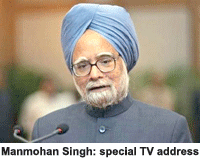The annual ‘Report to the People’ of the Congress-led 17-party coalition United Progre-ssive Alliance (UPA) government which completed four years of office in New Delhi on May 22, has accorded top priority to its achievements in the education and health sectors. “The focus of the Eleventh Five Year Plan is education. India is a nation of young people. I sincerely hope the initiatives we have taken in the field of education will unleash the creative potential of all our people. We have increased investment in education with the twin objectives of widening access and promoting excellence. Special emphasis is being laid on the empower-ment through education of SCs, STs, OBCs and minority communities and women,” prime minister Dr. Manmohan Singh wrote in the foreword of the UPA government’s Report to the People.
 Although the UPA’s self-congratulatory annual report makes great play about the Central government’s initiatives in higher education and the Union budget 2008-09, it is mum on the progress of important Bills — the right to education and the entry of foreign universities — and its promise made four years ago in the coalition’s CMP (common minimum programme) to raise the annual outlay (Centre plus states) on education to 6 percent of GDP.
Although the UPA’s self-congratulatory annual report makes great play about the Central government’s initiatives in higher education and the Union budget 2008-09, it is mum on the progress of important Bills — the right to education and the entry of foreign universities — and its promise made four years ago in the coalition’s CMP (common minimum programme) to raise the annual outlay (Centre plus states) on education to 6 percent of GDP.
According to sources in the Union HRD ministry, the entry of foreign universities into India is being vehemently opposed by the communist parties and the proposal is fated to go the way of the Indo-US nuclear deal. However, the Right to Education Bill, which makes it obligatory for the State (i.e government), rather than parents, to provide compulsory education to all children aged six-14 may be tabled in the forthcoming monsoon session of Parliament and enacted after the Planning Commission calculates its financial implications.
The report’s education chapter titled ‘Well read — always ahead’ says that the UPA government’s Education for All strategy has yielded good results and currently 96 percent of the country is covered by primary schools within 1 km of all cluster habitats, of which 85 percent have upper primary schools within walking distance. “The UPA government has announced the introduction of Rashtriya Madhyamik Shiksha Abhiyan to increase enrollment in secondary education by improving access to secondary schools and upgrading school infrastructure through an investment of Rs.35,000 crore during the Eleventh Plan. Six thousand high quality model schools will be started this year across the country to set standards of excellence for other schools, while another 3 million children in upper primaries have been added to 11 crore (110 million) children benefiting from cooked midday meal scheme,” says the report. Moreover to bridge the gender gap, 182,000 girls have been enrolled in 1,754 residential upper primary Kasturba Gandhi Balika Vidyalaya schools.
“The spread of primary education to the masses under the UPA government has been satisfactory but the continuously deteriorating quality of research in universities has not been addressed. Barring a dozen respectable research journals in the country which have a negligible impact factor, research publications under official patronage continue to mushroom and produce fake researchers who appropriate faculty appointments and promotions. Educationists’ voices are simply not heard in Parliament as there is hardly a normal and serious day in these ‘shouting’ houses,” says Dr. Ram Prakash, member consultative committee of the Union HRD ministry from the Rajya Sabha and an educationist.
Unsurprisingly, informed monitors of the education scene are less than impressed. “Four years in power, the UPA hasn’t been proactive and reformative in education. It has failed to facilitate and promote private institutes, innovation and the education potential of India,” comments Manohar Chellani, secretary general of the Delhi-based Education Promotion Society of India.
A determined prime minister may have at last wrested and rescued the UPA government’s education initiatives from the myopic mandarins of Shastri Bhavan who for the past four years have done little except take forward the schemes initiated by the previous NDA government. Perhaps the best that can be said about the UPA government is that it has transferred education from the periphery to the near centre of the national development debate.
Autar Nehru (Delhi)